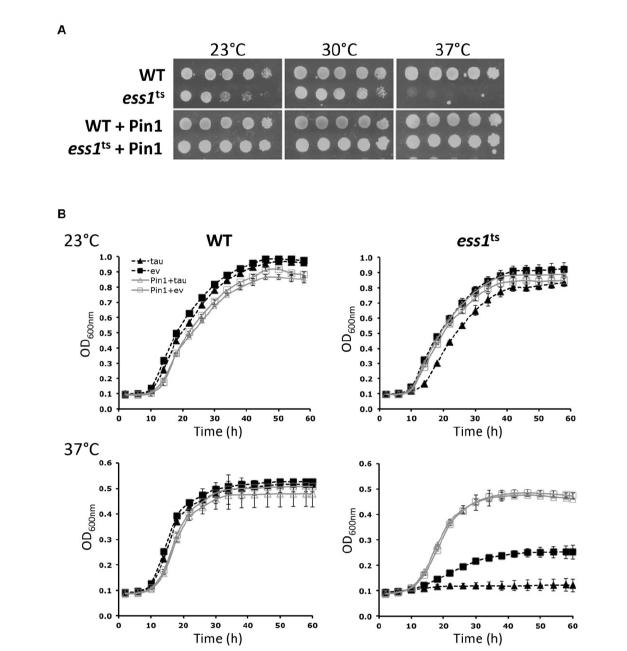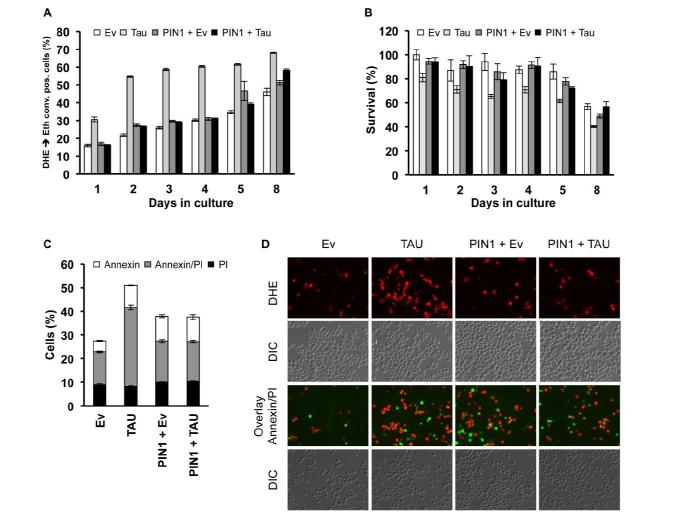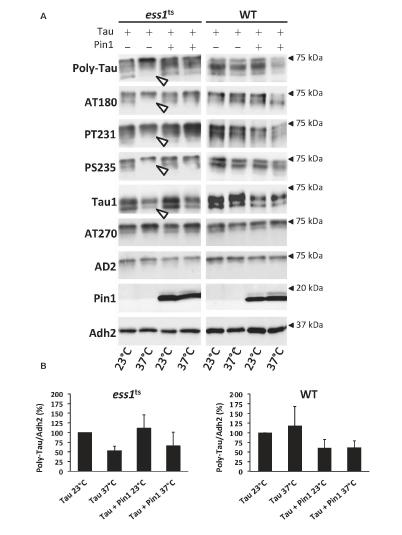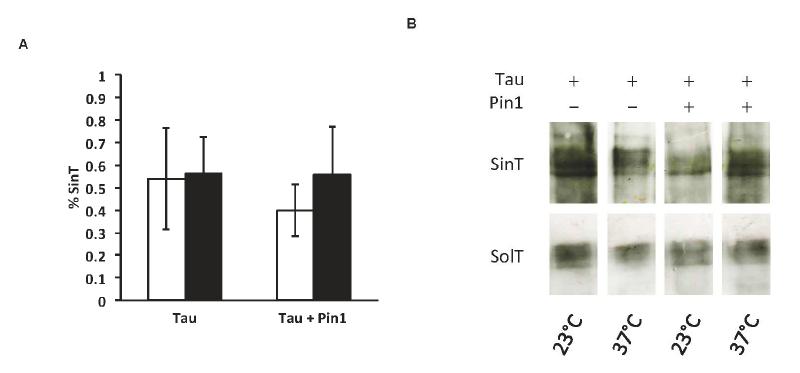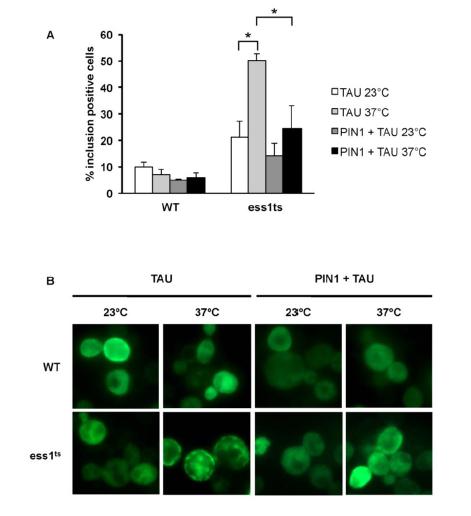1. Introduction
Tau protein is a microtubule associated protein (MAP), abundantly expressed in neurons of the central nervous system where it modulates the stability of axonal microtubules (MT). Binding to MT is dynamically controlled by reversible phosphorylation, as a result of the activities of different kinases and phosphatases. Abnormal phosphorylation of tau, however, results in aggregation of the protein and formation of paired helical filaments (PHF) and neurofibrillary tangles (NFT), major characteristics of many tauopathies including Alzheimer’s disease (AD). Since hyperphoshorylation is a crucial event in AD, kinase and phosphatase activities have been studied intensively [1]. In addition, the role of the peptidyl prolyl cis/trans isomerase (PPI) Pin1 has gained great interest. More specifically, Ser/Thr-Pro motifs in proteins can exist in two distinct conformations i.e. cis and trans, which slowly interconvert. However, the rate of conversion from the cis into the trans state can be significantly reduced by phosphorylation [2]. Hence, phosphorylation of protein tau on Thr231-Pro232 for example slows down the conversion from the cis to the trans state, ultimately making this tau residue a less favorable target for the trans-dependent phosphatase PP2A [3]. Furthermore, work with cis-specific antibodies showed that Thr231-phosphorylated tau in the cis-state, but not trans-state, is unable to promote MT assembly and is more prone to aggregation, besides being more resistant to dephosphorylation [4]. Pin1 recognizes specifically phospho-Ser/Thr-Pro motifs in proteins, like the AD-related phosphorylated proteins tau and APP [5,6], and facilitates the cis/trans interconversion of the proline amide bond [3,4,7]. Subsequently, Pin1 is able to restore the MAP function of phosphorylated tau [4,8,9] and to stimulate the dephosphorylation of the protein [3,4,9]. Other accumulating evidence demonstrates an association of the isomerase with AD. Pin1−/− mice display an age-dependent full-blown tau pathology [9]whereas a decreased Pin1 expression/activity is reported in case of AD [4,9,10,11].
In the past, we already presented the value of Saccharomyces cerevisiae as a model organism to analyse the effect of phosphorylation, conformation and aggregation of protein tau [12,13,14]. To our knowledge, there are no S. cerevisiae based models so far to study in vivo the role of Pin1 in tau pathology. Yet, an important advantage of using yeast as model for this purpose is that yeast cells express a Pin1 homolog, namely Ess1, the sole and essential parvulin-like isomerase in this organism [15]. Without Ess1, cells undergo mitotic arrest and nuclear fragmentation. When human Pin1 is expressed, the lethal phenotype is suppressed [16], indicating that human Pin1 can functionally substitute Ess1 and that the function of these two isomerases is highly conserved in eukaryotes.
Different strains are available with temperature sensitive ESS1 alleles, such as with the H164R mutation that affects the catalytic, PPIase domain of Ess1 [17]. This ts mutant of Ess1 maintains adequate isomerase activity at the permissive temperature (23 ℃) but largely loses this activity at the restrictive temperature (37 ℃). Moreover, the protein level of H164R mutant Ess1 seems to be reduced 2 to 10-fold under restricted circumstances. Consequently, the ess1ts strain displays a slow growth phenotype at 37 ℃ and undergoes mitotic arrest and nuclear fragmentation within 4 to 8 h [17]. Since isomerase activity can be reduced to an absolute minimum, the effect of deficiency of Pin1/Ess1 isomerase activity on the biochemical features of proteins can be studied in this particular ess1ts mutant strain.
Here we describe the development of a yeast model, based on the ess1ts (H164R) mutant strain, to examine the effect of Pin1 on the biochemical characteristics of protein tau. It was already shown that Pin1 promotes dephosphorylation of phospho-Thr231 [3,4] and, as more recently demonstrated, of the phospho-Ser202/phospho-Thr205-site, phospho-Thr212, phospho-Ser235 and phospho-Ser404 [7,18,19]. In this study, we noticed an elevated phosphorylation at Thr231, Ser235 and the Tau1 epitope (Ser198/199/202) due to the lack of Pin1 isomerase activity, confirming the studies mentioned above. Additionally, we observed an enhanced generation of inclusions in the ess1ts strain. However, this was not associated with higher levels of sarkosyl insoluble tau (SinT), which is considered to represent mature aggregates of the protein. These results suggest that the inclusions in the Pin1 yeast model are rather accumulations of monomeric/oligomeric tau or possibly protofibrils. Furthermore, despite the absence of increased SinT levels, we noted tau related toxicity in the yeast cells with minimum isomerase activity. Combined, these data (i) emphasize the importance of elevated phosphorylation at specific phospho-sites in the mechanisms leading to tau toxicity and (ii) correspond to the hypothesis that the aberrantly phosphorylated monomeric tau or intermediate filaments of the protein are the cytotoxic species rather than the full-blown aggregates.
2. Materials and Methods
2.1. Yeast cultures and growth conditions
In this study we used the Saccharomyces cerevisiae wild type W303-1A strain (MATa ura3-1 leu2-3, 112 trp1-1 can1-100 ade2-1 his3-11, 15 [phi+]) and the ess1ts strain, isogenic to the wild type W303-1A strain, with a temperature sensitive mutation in ESS1. The latter strain was a kind gift from the research group of Hanes [17]. Yeast cells were grown on YPD medium (2% bactopeptone, 1% yeast extract and 2% glucose) at respectively 30 ℃ and 23 ℃ in an orbital shaker at 220 rpm. Episomal plasmids with or without cDNA coding for human wild type Pin1 or human wild type tau (tau-2N/4R), inserted under the control of the strong constitutive TPI-promoter, were introduced into the yeast strains using a transformation technique based on Gietz et al. [20]. From that moment, the strains were grown at 30 ℃ or 23 ℃ on SC medium containing 0, 19% yeast nitrogen base, 0.5% (NH4)2SO4, 30 mg/L adenine, 80 mg/L histidine, 30 mg/L of all other amino acids (leucine and/or the pyrimidine uracil were omitted to serve as a selection marker) and 2% glucose (SCD). In order to monitor the growth profiles of the strains, late exponential phase pre-cultures of at least three independent transformants were used to inoculate new cultures in the appropriate medium at a starting OD600 of 0.01. Growth of the cells at 23 ℃ and 37 ℃ was measured at 600 nm in 96-well plates every two hours for 60 hours using a Multiscan™ GO Microplate Spectrophotometer (Thermo Scientific™). For growth assays on solid medium a serial dilution of exponentially growing cells was made in SCD medium ranging from an OD600 of 1 to 0.0001. Of these dilutions, 5 µL was spotted on SCD agar plates, which were then incubated at 23 ℃, 30 ℃ or 37 ℃ for at least 48 h.
2.2. Survival plating and test for apoptotic markers
Chronological aging experiments were performed as described [21,22], and representative aging experiments are shown.
Cultures were inoculated from fresh overnight cultures to reach approximately 2 × 106 cells/mL. For chronological aging experiments aliquots were taken out to perform survival plating and tests for cell death markers at indicated time points. Tests for apoptotic (Annexin V staining) and necrotic (PI staining) markers, as well as markers for oxidative stress (DHE staining), were performed as described previously [23]. For quantifications using flow cytometry (BD FACSAria), 30, 000 cells were evaluated and analyzed with BD FACSDiva software. Unstained and single stained samples served as controls for setting gates and proper compensation of respective channels (Annexin V detection, SL-1, FITC channel, exited by blue laser, PI detection, FL-6, PerCP-Cy5-5, exited by blue laser).
2.3. Staining procedures and epifluorescence microscopy analysis
Cells were applied to epifluorescence microscopy directly with the use of a small-band EGFP filter (Zeiss) on a Zeiss Axioskop microscope to monitor Annexin V positive cells, and a dsRed filter to monitor PI or ethidium positive cells.
2.4. Denaturating gel electrophoresis
Yeast cells were grown at 23 ℃ or 37 ℃ until an OD600 of 2.0 and harvested by short centrifugation, followed by boiling for 15 minutes in SDS sample buffer (50 mM TRIS pH 8.0; 2% SDS; 0.1% bromophenol blue, 10% glycerol, 10 mM β-mercapto-ethanol). Tris-glycine gels (7.5% or 15%) were used to separate the proteins, which were transferred after separation to Immobilon-P membranes (Millipore, Billerica, MA). The primary and secondary antibodies chosen for this study are listed in Table 1. For detection, the ECL method was applied using a kit from Pierce Perbio (Belgium).
Table 1. The primary and secondary antibodies chosen for this study
|
Antibody
|
Specificity
|
Source
|
|
PolyTau
|
Phosphorylation independent
|
Innogenetics, Belgium
|
|
AT180
|
Phospho-Thr231/Phospho-Ser235
|
Innogenetics, Belgium
|
|
PT231
|
Phospho-Thr231
|
Calbiochem, Merck, Germany
|
|
PS235
|
Phospho-Ser235
|
Abazyme, Needham, USA
|
|
Tau1
|
Ser198/Ser199/Ser202
|
Chemicon, Temecula, CA
|
|
AT270
|
Phospho-Thr181
|
Innogenetics, Belgium
|
|
AD2
|
Phospho-Ser396/Phospho-Ser404
|
BIO-RAD, Hercules, CA
|
|
Pin1 (H-123)
|
aa 41-163 of Pin1
|
Santa Cruz Biotech. Inc.
|
|
Adh2
|
anti-alcohol dehydrogenase
|
Chemicon, Temecula, CA
|
2.5. Sarkosyl insolubility assay
45 mL of a yeast culture of OD600 of 2.0 was harvested by centrifugation and stored minimal 1 hour at −80 ℃. The pellet was resuspended in 2 mL TBS+ buffer (25 mM Tris pH 7.7; 150 mM NaCl; protease inhibitor cocktail; 0.5 mM PMSF; 1 mM EDTA; 0.2 mM Na3VO4; 20 mM NaF; 10 µM okadaic acid) and transferred to a falcon tube with glass beads. Cells were homogenized at 4 ℃ by vortexing for 1 minute followed by incubation on ice for 1 minute (20×). After adding 2 mL TBS+ buffer complemented with 1.6 M NaCl and 0.58 M sucrose, the samples were mixed briefly and put on ice during 5 minutes. Subsequently, the samples were centrifugated (30 minutes; 20,000 g; 4 ℃) and Sarkosyl (N-lauroyl-sarkosine) (Sigma, Belgium) was added to the supernatant to a final concentration of 1% w/v. Following incubation at 4 ℃ during 1 hour and ultracentrifugation (40 minutes; 150,000 g; 4 ℃), the supernatant was stored at −20 ℃. After washing the pellet with a mix of the two used TBS buffers complemented with Sarkosyl (ratio: 45/45/10), it was resuspended in pre-heated SDS sample buffer (50 mM TRIS pH 8.0; 2% SDS; 0.1% bromophenol blue, 10% glycerol, 10 mM β-mercapto-ethanol), boiled for 15 minutes at 95 ℃ and finally stored at −20 ℃.
2.6. In situ immunofluorescence
Yeast cells were grown at the adequate temperature until an OD600 of 2.0 before fixing them with 4% formaldehyde for 15 minutes. After washing with a 0.1 M phosphate buffer solution (PB) (1 M: 32.95 mL K2HPO4 1 M; 67.05 mL KH2PO4 1 M; pH 6.5), formaldehyde was again added to a final concentration of 4% for a second fixation (2 h). After a few washing steps, cells were resuspended in PB complemented with 1.2 M Sorbitol, 10 µL β-mercapto ethanol and 10 µL Lyticase (10 mg/mL) (Sigma, Belgium). Incubation at 30 ℃ during 1h resulted in spheroplasts, which were fixed upon a poly-lysine coated slide (Menzel-Gläser, Braunschweig, Germany), subsequently submerged in ice-cold methanol and acetone (6 minutes respectively 30 seconds at −20 ℃) and blocked with PBST buffer (0.04 M K2HPO4; 0.01 M KH2PO4; 0.15 M NaCl; 0.1 g/100 mL NaN3; 0.1% Tween20) and BSA (10 mg/mL) during 30 minutes at room temperature. The spheroplasts were incubated with a primary antibody overnight (at 4 ℃) or during 2 hours (at room temperature). After washing with PBST buffer, suspensions of secondary antibodies (Alexa Fluor® Dyes; Invitrogen, Belgium) were added for 2 h in the dark. After washing, the slides were completely dried and mounting medium (PPD) was applied for analysis with a fluorescence microscope, model DFC420C, Leica.
3. Results
3.1. Depletion of Ess1 leads to slow growth that can be restored by expression of human Pin1
We constitutively expressed human wild type (WT) Pin1 from a high copy number plasmid in the W303-1A WT yeast strain and its isogenic ess1ts strain and monitored the effect on growth. As illustrated in Figure 1A, the growth of the WT strain, with or without expression of human Pin1, was not affected by temperature. In contrast, the ess1ts strain grown at restrictive temperature experienced a significant decrease in growth. Consistent with a study by Wu and co-workers [17], expression of human Pin1 restored the ess1ts related growth phenotype. The expression of human Pin1 in the WT as well as ess1ts strain was verified by Western blot analysis (Figure 3).
3.2. Depletion of Ess1 leads to tau toxicity in yeast
To study the interplay between Pin1 and protein tau in vivo, human WT tau was expressed alone or in combination with Pin1 in the WT strain and the ess1ts strain. Growth analysis demonstrated that expression of the tau protein did not affect the growth of the WT yeast cells. Co-expression of Pin1 did also not result in tau-related growth differences (Figure 1B). In contrast to the WT strain, expression of tau in ess1ts cells did cause significant changes in the growth properties of the strain. Besides a general decrease in growth at restrictive temperature, the ess1ts strain experienced an additional growth defect due to expression of tau. Co-expression of Pin1 at restrictive temperature resorted the tau-related toxicity (Figure 1B).
3.3. Tau enhances cell death in aged ess1ts yeast cells
First we measured the number of cells with increased reactive oxygen species (ROS) formation in the different ess1ts strains. Quantification of ROS production was analyzed by the superoxide-driven conversion of non-fluorescent DHE into fluorescent ethidium. As shown in Figure 2A and D, the presence of tau in the ess1ts cells significantly increased the amount of ROS positive cells, even when grown at the permissive temperature. At restrictive temperature the effect of tau on ROS production was less pronounced because the cells died quickly at 37 ℃ (data not shown). Co-expression of Pin1 counteracted the tau-induced ROS formation and this appeared to be independent of the temperature at which the cells were grown. Furthermore, we monitored the effect of tau on cell survival and cell death. As expected, the percentage of surviving cells correlated nicely with the ROS levels (Figure 2B). By co-staining with Annexin V and propidium iodide (PI), we discriminated between early apoptosis (Annexin V+), late apoptosis eventually leading to secondary necrosis (Annexin V+/PI+), and primary necrosis (PI+). As shown in Figure 2C and D, there was a strong increase in the level of late apoptotic cells (Annexin V+/PI+) in case of the ess1ts strain expressing tau, already at the permissive temperature. Co-expression of Pin1 reduced the number of apoptotic cells and completely annihilated tau associated toxicity.
3.4. Pin1/Ess1 affects the phosphorylation pattern of human tau expressed in yeast
Next, we investigated via Western blot (WB) and immunodetection if the observed tau related toxicity in the ess1ts cells could be linked to changes in phosphorylation of the protein or to differences in expression level of tau. As illustrated in Figure 3A, WB analysis, with the phosphorylation independent antibody Poly-Tau, of total protein extracts of WT cells expressing tau revealed distinct variants of the protein, ranging from 64 to 74 kDa. This was consistent with previous studies in yeast where the mixture of tau variants was shown to represent different phosphorylation forms of tau [13]. To specify the phosphorylation of the protein, a phospho-epitope scan was performed using different phospho-specific antibodies that recognize phosphorylated epitopes retrieved in Alzheimer brain. Apparently, protein tau expressed in WT yeast is phosphorylated in a similar way as AD tau since the protein yeast extracts reacted to every antibody used. Co-expression of Pin1 in WT cells did not change the phosphorylation of tau, nor did it significantly change the expression level of the protein (Figure 3B). The total protein level of tau in the yeast cells was gauged as the immuno-response of the Poly-Tau antibody in the extracts versus the immuno-response of an antibody towards Adh2, a typical yeast housekeeping gene. Regarding the ess1ts strain, the phosphorylation pattern of tau resembled the phosphorylation pattern in the WT strain under permissive conditions, independent of co-expression of Pin1. However, when the ess1ts cells were grown at restrictive temperature, a shift in electrophoretic mobility of tau was detected, while the expression level of tau did not significantly change (Figure 3B). In this case, the tau-variant with the highest electrophoretic mobility, i.e. the lowest degree of phosphorylation, decreased and a shift towards the variants with higher phosphorylation status occurred (Figure 3A).
Using different phospho-specific antibodies, we obtained more detailed information on which epitopes of tau were actually affected by Pin1, Ess1 or both in yeast. As shown in Figure 3A, tau expressed in the ess1ts strain grown at 37 ℃ revealed an upward shift in electrophoretic mobility when analysis was performed with the AT180, PT231 and PS235 antibodies (marked by open arrow). Expression of Pin1 counteracted this effect. Additionally, when WB analysis was performed with the antibody Tau1, the immunoreactivity of the protein extracts clearly decreased in case of minimal isomerase activity, implying a higher phosphorylation of tau at those particular residues.
On the other hand, neither Ess1 nor Pin1 had an effect on the phosphorylation of tau at Thr181 (AT270) and Ser396 and Ser404 (AD2) as illustrated in Figure 3A.
3.5. The lack of isomerase activity does not influence aggregation of human tau expressed in yeast
Next, we tested whether a lack of isomerase activity affects aggregation of tau in yeast as well. To this end, we performed a Sarkosyl insolubility assay. Sarkosyl or N-lauroyl-sarkosine is a detergent in which the solubility of a protein can be analyzed. The fraction of tau which is no longer soluble in 1% Sarkosyl (SinT; Sarkosyl insoluble fraction of tau) is considered as aggregated tau. Remarkably, the SinT levels of tau expressed in the ess1ts strain do not change in case the cells are grown at restrictive temperature, nor do the levels vary with any statistical significance when Pin1 is co-expressed (Figure 4).
3.6. Depletion of Ess1 increases the inclusion formation of human tau expressed in yeast cells
Finally, we investigated the localization and inclusion formation of tau in WT and ess1ts cells using in situ immunofluorescence. In the WT cells, tau was found dispersed in the cytoplasm. Only a small number of cells displayed inclusions of tau, which did not change significantly by the presence of Pin1 (Figure 5A and B). In contrast, when the incubation temperature of the ess1ts strain was switched from 23 ℃ to 37 ℃, the localization of tau changed from diffuse distribution in the cytosol to small foci located at the periphery of the cell. Co-expression of Pin1 inhibited inclusion formation of tau and clearly maintained the diffuse cytosolic tau localization (p < 0.05), even under conditions of restricted Ess1 activity where the level of cells with tau inclusions was significantly increased (p < 0.05) (Figure 5A and B).
4. Discussion
Studies in the field of AD, focused on deciphering the role of the peptidyl prolyl cis/trans isomerase Pin1, illustrated that this isomerase is able to restore the ability of phosphorylated tau to properly induce MT assembly and/or to promote the dephosphorylation of tau. In order to do so, the isomerase binds to phosphorylated Thr/Ser-Pro residues on protein tau [3,4,6,7,8,9,18,24,25]. Although the majority of these findings is based on in vitro assays or work in multifaceted models, like Pin1−/− mice, more straightforward eukaryotic models are finding their way into the research on Pin1, i.e. models based on the baker’s yeast S. cerevisiae [3,16,17]. Various mutants of Pin1 have been expressed in and purified from yeast strains, to determine in vitro which domains of the isomerase are important for the interaction with phospho-proteins like tau or to isomerize the phospho-Thr/Ser-Pro bonds. The isomerase-activity of Pin1 purified from yeast was confirmed in vitro as essential for regulating the dephosphorylation of tau by the phosphatase PP2A [3]. In a next step towards investigating the relationship between Pin1 and protein tau in vivo, we now expressed human protein tau in a S. cerevisiae strain where a temperature sensitive mutation was introduced in Ess1, the only and therefore, essential yeast homologue of human Pin1 [15]. Besides a decreased basal expression level of H164R-mutated Ess1, this mutant form of the yeast isomerase only maintains an adequate isomerase activity at permissive temperature. At restricted temperature, isomerase activity is reduced to an absolute minimum and leads to mitotic arrest, which can be reversed by expression of human Pin1 [16,17]. In our study, we developed a S. cerevisiae based model, founded on the ess1ts mutant strain, to examine the effect of Pin1 on the biochemical characteristics of protein tau in vivo. We were able to document an effect of Pin1 on the phosphorylation of protein tau at the AT180 epitope, corresponding to many previous studies where Pin1 affects dephosphorylation of phospho-Thr231 [3,4,18,24,25]. Noteworthy, the AT180 antibody recognizes phospho-Thr231 as well as phospho-Ser235 and apparently, Pin1 also affects phosphorylation at the latter residue. This could be due to primed phosphorylation events, which have been shown to affect the MT binding ability of tau even more. Namely, GSK-3b phosphorylates Thr231, subsequent to phosphorylation of Ser235 [26]. By targeting phospho-Ser235, Pin1 could prevent phosphorylation of Thr231, thereby helping in preserving the interaction between tau and MT.
Next to the AT180 epitope, we registered an effect by Pin1 on the phosphorylation of other sites, i.e. Ser198, Ser199 and/or Ser202 (Tau1 epitope). Phosphorylation at Ser199 was already shown to be modulated by Pin1 in hippocampal cultured neurons [27]. Nonetheless, in this particular study and another more recently published study [19], Pin1 also affected the phosphorylation at the AD2 epitope, whereas we did not observe this effect, nor did other research groups [24,25]. Possibly, these contradictory results could be explained by differences in Pin1 activity in the various reports. We studied yeast cells without the involvement of external factors, whereas Bulbarelli and co-workers [27] treated cultured neuronal cells with Ab42oligomers. Since up-regulation of Pin1 activity would be part of the self-defense mechanism of the cell in Alzheimer onset, the extra boost in Pin1 activity in the study by Bulbarelli could explain a supplementary effect on the phosphorylation of protein tau. With respect to Ser202, Pin1 was previously shown to affect the phosphorylation of this residue indirectly. Through a NMR spectroscopy study, phosphorylation of Thr231 was demonstrated to negatively influence the dephosphorylation of the AT8 epitope, which partially overlaps with the Tau1 epitope, i.e. phospho-Ser202 and phospho-Thr205. Thus, a priming dephosphorylation of phospho-Thr231 is required for efficient PP2A-mediated dephosphorylation of phospho-Ser202 and phospho-Thr205, a process facilitated by Pin1 [18]. Since Pin1 isomerase activity is depleted in the ess1ts strain, dephosphorylation of phospho-Ser202 could also be impaired.
Increasing evidence suggests that the toxic species of protein tau are the hyperphosphorylated monomers, oligomers and/or intermediate tau filaments, rather than the NFT [28,29]. Actually, the NFT could be inert or neuro-protective [30,31,32]. The memory of mice improves in case of suppressing the expression of tau, despite of the continuous accumulation of NFT [33]. Accordingly, in yeast, events such as exposure to Fe2+ result in elevated SinT levels and increase in the amount of inclusions but this is not correlated with reduced growth of the cells [14]. On the contrary, as demonstrated in the current study, expression of protein tau in yeast in which Ess1 is inactivated does induce a growth defect without increased SinT levels. Interestingly, AT180 phosphorylation of tau is increased in cells with impaired Ess1 activity, whereas tau expressed in wild type yeast treated with Fe2+ displays decreased AT180 immunoreactivity [14]. These findings suggest that an altered phosphorylation status of tau is the culprit, not the elevation in SinT-levels. Most likely, these observations are linked to Pin1 activity. Dephosphorylation of tau at phospho-Thr231 by PP2A upon oxidative stress has previously been noted to significantly rely on Pin1 in neuronal cell cultures [24]. In our study, co-expression of Pin1 in the ess1ts strain restores a normal phosphorylation level at the AT180 epitope, consistent with other studies where Pin1 promotes dephosphorylation of phospho-Thr231 [24,25]. Combined, this strengthens the hypothesis that Pin1 could represent a response of the cells to convert toxic tau accumulations into inert inclusions. One may even argue that Pin1 is actually needed for the self-assembly of tau into higher order filaments. In AD brain tissue, Pin1 has been found to co-localize with accumulations of phosphorylated tau [34], even in the most insoluble hyperphosphorylated tau fraction [10]. It is possible that the aggregated hyperphosphorylated tau sequesters the isomerase, but it might as well be that Pin1 binds to tau in order to form neuro-protective NFT. This would explain why SinT levels do not increase significantly when isomerase activity is absent in the ess1ts strain, while tau appears toxic to the yeast cell.
Although depletion of Pin1 activity clearly affects inclusion formation of protein tau expressed in yeast, future investigation is needed to identify the exact nature of these inclusions. Protein tau seems to accumulate at the periphery of the cell, which raises the question whether the inclusion formation can be induced by interaction of tau with membranous structures like lipid raft domains. There are several studies demonstrating the involvement of lipid rafts in AD but also other neurodegenerative disorders such as Parkinson’s disease and prion diseases, where they could serve as sites of protein processing [35,36,37,38,39]. An accumulationof phosphorylated tau was shown to occur in lipid rafts [40,41,42] and interestingly, in yeast, a fraction of tau is associated with these particular structures (unpublished data). Yet, a study by Maas and co-workers [43], highlights a high Tau1 and no AT180 immunoreactivity in case tau is associated with the plasma membrane, which does not apply for tau in the ess1ts strain at restrictive temperature. Still, this would not necessarily rule out an interaction with lipid rafts since these are specialized microdomains of the plasma membrane, with other characteristics [44]. Alternatively, protein tau has been shown to interact with Golgi membranous structures to regulate their interaction with MT and this occurs upon phosphorylation of tau at e. g. Ser202 and PHF-1 sites, which overlap with the Tau1 and AD2 sites respectively [45]. In addition, accumulations of protein tau hyperphosphorylated at the AT8 site apparently induce fragmentation and subsequent loss of the Golgi-apparatus in cell lines and mice [46]. Therefore, interference with the Golgi system could also be a possible cause for cytotoxicity of tau in the ess1tscells.
5. Conclusion
In the past, S. cerevisiae has already been useful as a model organism to analyze the effect of phosphorylation, conformation and aggregation of tau [12,13,14]. We can conclude from this study that baker’s yeast can now also be chosen to investigate the effect of Pin1 activity on protein tau, to gain detailed insights in the Pin1-tau relationship. By expressing tau in the ess1ts yeast strain, we are not only able to restate the effect of Pin1 on dephosphorylation of tau at multiple residues, we can also study the influence of the isomerase on the assembly properties of tau, which underscores the potential of using yeast as a model system for tau pathology.
Acknowledgments
We are grateful to Ilse Bastiaens and Hanne Grosemans for technical assistance. We like to thank Dr. Hanes for the ess1ts strain. The investigation was supported by grants of Research Foundation Flanders (FWO-Vlaanderen) (to V.F. and J.W.), by the Foundation for Alzheimer Research (SAO) (to V.F.) and by grants of the KU Leuven Research Fund and KU Leuven R&D (to J.W.). This work was also supported by LabEx (Excellence Laboratory), DISTALZ (Development of Innovative Strategies for a Transdisciplinary Approach to Alzheimer’s Disease), INSERM (Institut National de la santé et de la recherche médicale), LMCU (Lille Métropole Communauté urbaine), Région Nord/Pas-de-Calais, and FEDER (Fonds Européen de Développement Economique et Régional) (to M.C.G.) and the Austrian Science Fund FWF (grants LIPOTOX, I1000-B20, P23490-B12, and P24381-B20 to FM) and NAWI Graz (to J.R. and F.M.).
Conflict of interest
J.W. reports that he is cofounder of the university spin-offs ReMYND NV (Leuven, Belgium) and ADx NeuroSciences NV (Ghent, Belgium) but this did not influence in any way the studies, experiments or outcomes reported in this manuscript.









 DownLoad:
DownLoad: 